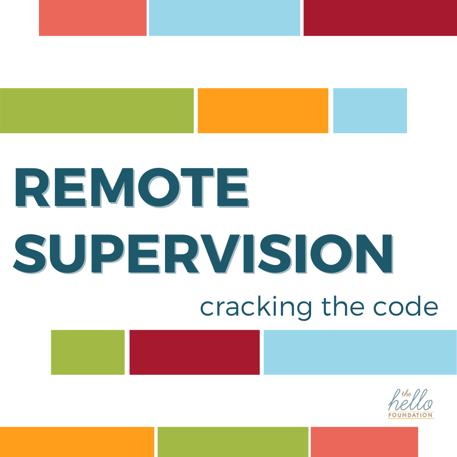
The learning curve for supervising remote staff can be a rather steep one, especially when living in a "building-the-plane-while-we're-flying-it" reality. The good news is that, while remote work may be a new frontier for many in public education, it is a well-established practice in other industries. In fact, before the pandemic, fully one-quarter of the workforce worked from home! Here's how we can incorporate remote supervision best practices into what we already know about employee supervision the public schools.

Teamwork and Culture
One of the critical elements of good supervision is helping staff learn and understand your team's culture and how they fit into it. This is something that takes a more conscious effort in the remote world, as employees don't have the cues provided by a shared physical space. For example, if you have core values or a mission statement for your school or district, those are probably prominently featured in the building. Or maybe you would ordinarily display a theme for the school year or an inspirational quote for staff to rally around. How can you virtually share those ideas? Think about things like creating an email signature for everyone on your team, a custom virtual meeting background with your values, a shared google slide for everyone to use, or even feature them in a Bitmoji virtual classroom. Thinking about new ways to communicate to your staff that you're all working towards a common goal and on the same team will give you an essential touchpoint for future conversations with employees.
You'll likely also have to put in some extra effort to promote teamwork and team unity when supervising virtually. In-person meetings have a natural flow of people arriving, chatting, perhaps staying afterward to catch-up or walk to the parking lot together. Those things are hard to replicate in a virtual meeting, so you'll need to make it happen intentionally. Make time on the agenda to check-in on life outside of work, get to know each other, and share victories and defeats. Most of all, don't forget to have fun and laugh together! Celebrate birthdays with virtual cards signed by the whole group, and consider having special treats delivered to employees just because.
Transparency and Boundaries
When you're working in a shared physical space, it is easy to see who is in the office, when they arrive, when they leave, and generally what they're up to. An empty desk or a closed door means that a person is not available, and that's pretty clear. The virtual world does not have these same cues, so creating and communicating them is critical to your remote supervision success.
It is imperative that you "respect the workday" for yourself and your staff when remote working. Take the time to think about your workday and that of your employees. What time does it start? When does it end? When are you at your virtual desk and open to chatting, and when is your virtual door closed? When and how often will you be observing staff with students? Put your schedule down in a document that you can share with staff, or if your organization allows calendars to be shared, share yours with your team. Require that they do the same. Staff should know when and how best to access you, and likewise, you should know the same for them. Model good work-life boundaries by not emailing, messaging, or calling outside of your communicated workday hours. Make sure your employees know that, outside of an emergency, you won't be responding to communication outside those hours. Doing all of these things will ensure that, even if work and home are the same physical space, there's still a distinction between the two.
Expectations and Feedback
Communicating expectations and providing feedback is one area where remote supervision does not differ significantly from in-person supervision. Both models require that you are clear and concise when setting forth expectations for staff and that all staff are held accountable to meet those expectations. While remote supervising, it is just as important as always that you work with your team to set goals, evaluate them on a regular schedule, and offer constructive feedback. Your district likely has HR policies in place regarding supervision cycles. Regardless of which learning model your district is using this year, it is still your responsibility to adhere to them.
Giving meaningful feedback can feel more challenging in the virtual environment because online learning is still so new to most of us, and we're not sure about what it should look like or what suggestions might be helpful. Depending on your team's size, consider a weekly check-in with your whole team, small groups, or individuals. Let this be a regularly-scheduled time that your staff knows that they have access to you, can ask you questions, share concerns, and use you as a resource. You can also use this time to share things you're noticing, both strengths and weaknesses, and to problem-solve.
--
Above all else, it's perhaps most important that you are patient with yourself as you adjust to this new way of doing your old job. It's hard work doing something for the first time, and there are bound to be missteps along the way. If you're able to model humility, humor, and a growth mindset for your staff, you'll be well on your way to cracking the remote supervision code.
